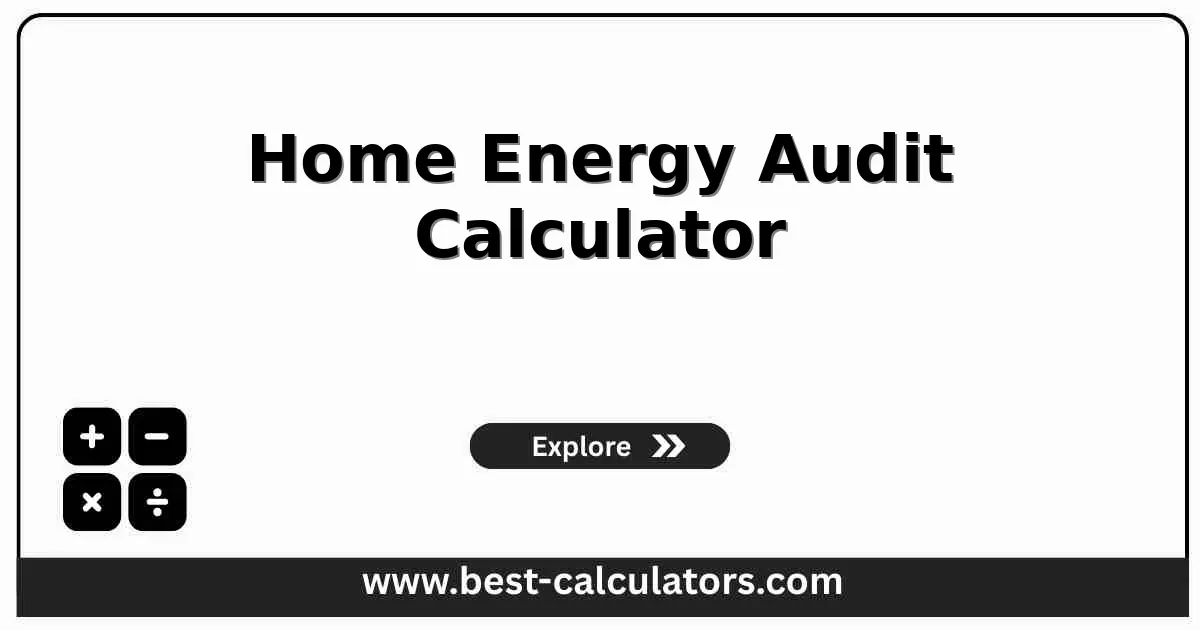Home Energy Audit Calculator
Calculate your home's energy consumption, identify inefficiencies, and discover potential savings opportunities
Energy Consumption Inputs
Energy Audit Results
What is a Home Energy Audit Calculator?
A Home Energy Audit Calculator evaluates your home's energy consumption across all major systems including heating, cooling, lighting, appliances, and electronics. It identifies where energy is being used, wasted, and provides actionable recommendations for reducing consumption and costs.
Energy audits help homeowners understand:
- Energy consumption patterns - Which systems use the most energy
- Cost breakdown - Exact monthly and annual energy expenses
- Inefficiencies - Areas where energy is wasted
- Savings opportunities - Where upgrades provide the best ROI
To calculate potential savings from upgrading to energy-efficient lighting, use our LED vs Incandescent Bulb Savings Calculator to compare costs and determine payback periods for LED bulb investments.
For evaluating solar panel installation to reduce grid electricity consumption, try our Solar Panel Savings Calculator to estimate system costs, energy production, and long-term financial benefits.
To assess insulation improvements for HVAC efficiency, use our Home Insulation ROI Calculator to calculate installation costs and potential heating and cooling savings.
For comparing appliance energy efficiency, check our Energy Star Appliance Savings Calculator to determine cost savings from upgrading to Energy Star certified appliances.
How Home Energy Audit Calculator Works
The calculator analyzes energy consumption using these formulas:
= (HVAC Watts × Hours/Day × 30 Days) ÷ 1000
= [(Incandescent × 60W) + (LED × 10W)] × Hours/Day × 30 ÷ 1000
= Water Heater Wattage × Hours/Day × 30 ÷ 1000
= Number of Devices × 5W Average × 24 Hours × 30 ÷ 1000
Monthly Cost = Total kWh × Electricity Rate ($/kWh)
The calculator aggregates consumption across all categories to provide comprehensive energy usage analysis and cost projections.
Key Energy Audit Concepts
Phantom Load
Energy consumed by devices in standby mode. Accounts for 5-10% of residential electricity use. Unplug chargers and use power strips to eliminate waste.
HVAC Efficiency
Heating and cooling typically represent 40-50% of home energy use. Proper maintenance, insulation, and smart thermostats can reduce consumption by 20-30%.
Lighting Efficiency
LED bulbs use 75% less energy than incandescent bulbs and last 25 times longer. Switching all bulbs can save $100-200 annually.
Energy Star Rating
Energy Star appliances use 10-50% less energy than standard models. Look for the label when purchasing new refrigerators, washers, and dishwashers.
How to Use This Energy Audit Calculator
Enter Home Details
Input your home size and local electricity rate (check your utility bill for $/kWh)
Input HVAC Usage
Estimate daily hours your heating/cooling system runs and its power rating
Specify Appliances
Count major appliances, electronics, and lighting throughout your home
Review Breakdown
Analyze energy consumption by category and identify highest-cost areas
Implement Savings
Focus on highest-cost categories first for maximum financial impact
Benefits of Home Energy Audits
- • Reduce Energy Bills: Identify inefficiencies and save 10-30% on monthly electricity costs through targeted improvements.
- • Increase Home Value: Energy-efficient homes sell faster and command higher prices in real estate markets.
- • Environmental Impact: Lower energy consumption reduces carbon footprint and contributes to sustainability goals.
- • Comfort Improvement: Better insulation and efficient HVAC systems maintain consistent temperatures year-round.
- • Informed Decisions: Data-driven insights help prioritize upgrades based on ROI and payback periods.
- • Utility Rebates: Many utilities offer rebates for energy audits and efficiency improvements, offsetting upgrade costs.
Factors That Affect Home Energy Use
1. Climate & Weather
Extreme temperatures increase HVAC usage significantly. Homes in hot or cold climates use 40-60% more energy than moderate climates.
2. Home Age & Insulation
Older homes with poor insulation lose 25-40% of heated/cooled air. Modern insulation standards can reduce HVAC costs by 20-30%.
3. Appliance Efficiency
Old appliances use 2-3 times more energy than Energy Star models. A 15-year-old refrigerator costs $100-150 more annually to run.
4. Occupancy & Behavior
Number of occupants, thermostat settings, and usage habits dramatically impact consumption. Smart thermostats can save 10-23% automatically.

Frequently Asked Questions
How often should I conduct a home energy audit?
Conduct a home energy audit annually or whenever you make significant changes to your home, such as adding appliances, upgrading HVAC systems, or renovating spaces.
What are the biggest energy wasters in most homes?
The biggest energy wasters are typically heating and cooling systems (40-50%), water heaters (15-20%), lighting (10-15%), and appliances like refrigerators and washers (10-15%).
Can a home energy audit save me money?
Yes, identifying energy inefficiencies can save 10-30% on energy bills annually. Simple fixes like sealing air leaks and upgrading to LED bulbs provide immediate savings.
What is phantom energy consumption?
Phantom energy, or standby power, is electricity consumed by devices when turned off but still plugged in. This can account for 5-10% of residential electricity use.
How accurate is this calculator?
This calculator provides estimates based on average appliance usage and typical energy consumption patterns. For precise measurements, use an energy monitor or professional audit.